The association of endophytic bacteria with their plant hosts has been shown to have a growth-promoting effect for many plant species. Endophytic bacteria have several mechanisms by which they can promote plant growth and health on marginal, polluted soils. These include the production of phytohormones or enzymes involved in growth regulator metabolism such as ethylene, 1-aminocyclopropane-1-carboxylic acid (ACC) deaminase, auxins, indoleacetic acid (IAA) or cytokinins. In addition, endophytic bacteria can help their host plants to overcome the phytotoxic effects caused by environmental contamination. When dealing with organic contaminants, the benefical effects of endophytes can be enhanced by equipping them with the appropriate degradation pathways that complement the metabolic properties of their host plant. The idea behind this concept was that it is much easier to engineer the metabolic properties of a microorganism than those of a plant. We demonstrated that endophytic bacteria equipped with the tom toluene degradation pathway can significantly improve the in planta degradation of BTEX and TCE in poplar, resulting in reduced phytotoxicity and release. Recent research by our group illustrates the potential of endophytic bacteria to increase the biomass production of poplar. Our goal is to identify endophytic bacteria that improve the growth and phytoremediation potential of poplar on marginal, contaminated soils. Pseudomonas putida W619 was isolated from Populus trichocarpa x deltoides cv. "Hoogvorst" and represented one of the most commonly found species among the poplar endophytes isolated so far. Identical bacteria were isolated from the poplar rhizosphere, and as endophytes from root and stem material. Based on its 16S rDNA sequence as well as preliminary genome comparisons, strain W619 is closely related to P. putida KT2440, a plant growth promoting rhizosphere strain whose genome has been completely sequenced by TIGR. The presence of the KT2440 sequence should facilitate a comparison between the two genome sequences, and should allow identification of gene functions that are required for the endophytic behavior of P. putida W619. Dr. Daniel van der Lelie, M.B.A. |
||
|
||
Pseudomonas putida W619

 Courtesey of Brookhaven National Laboratory. The bar is 100nm.
Courtesey of Brookhaven National Laboratory. The bar is 100nm.